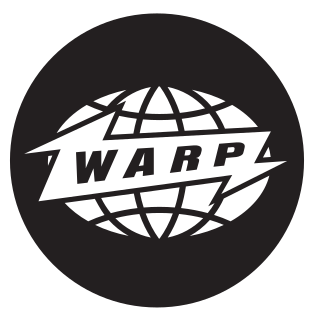Trance is a genre of electronic dance music that emerged from the British new-age music scene and the early 1990s German techno and hardcore scenes.
Intelligent dance music is a style of electronic music originating in the early 1990s that is regarded as "cerebral" and better suited to home listening than dancing. Emerging from electronic and rave music styles such as ambient techno, acid house, and breakbeat, IDM tended to rely upon individualistic experimentation rather than adhering to characteristics associated with specific genres. Prominent artists associated with the genre include Aphex Twin, μ-Ziq, the Black Dog, the Orb, the Future Sound of London, Autechre, Luke Vibert, Squarepusher, Venetian Snares, and Boards of Canada.

Warp Records is a British independent record label founded in Sheffield in 1989 by record store employees Steve Beckett, Rob Mitchell and record producer Robert Gordon. It is currently based in London.
Vocal trance is a subgenre of trance music that focuses on vocals and melodies. The subgenre came into existence in the early 1990s, when trance was still developing. Although many early trance records used vocal samples mixed in with the beats, the earliest examples of the style appeared in 1992–93.

The Roland JP-8000 is an analog modeling synthesizer released by the Roland Corporation in 1996.

A drop or beat drop in music, made popular by electronic dance music (EDM) styles, is a point in a music track where a sudden change of rhythm or bass line occurs, which is preceded by a build-up section and break.
Electronic dance music (EDM), also known as dance music, club music, or simply dance, is a broad range of percussive electronic music genres made largely for nightclubs, raves, and festivals. It is generally produced for playback by DJs who create seamless selections of tracks, called a mix, by segueing from one recording to another. EDM producers also perform their music live in a concert or festival setting in what is sometimes called a live PA.
Uplifting trance is a broad subgenre of trance music. The name, which emerged in the wake of progressive trance in 1996, is derived from the feeling which listeners claim to get. The genre, which originated in Germany, is massively popular in the trance scene, and is one of the dominant forms of dance music worldwide. Historically it is related to the emergence of psychedelic trance and the two styles influenced each other. Classical music strongly influenced the development of uplifting trance both in the 1990s and in the 2000s, with film music also considered influential.
Stephen James Wilkinson, better known as Bibio, is an English musician and producer. He is known for a distinct analog lo-fi sound, and for working in a diverse range of genres, beginning in folktronica and ambient and later stretching to include instrumental hip hop, indie pop, electronica, soul, funk, and alternative R&B.
Goa Mix, also known as The Goa Mix, is a two-hour DJ mix by British musician and DJ Paul Oakenfold. It was originally broadcast on BBC Radio 1 as an Essential Mix on 18 December 1994 after the producer of the show, Eddie Gordon, chose Oakenfold to produce an eclectic DJ mix for the show which featured a burgeoning variation of electronic styles, having begun the previous year. Oakenfold had, at this point, developed his own unique Goa trance sound, influenced by his time at hippy gatherings on beaches in Goa, and employed it heavily into the mix, which also made pioneering use of film score samples. Oakenfold used the mix as an experiment in which he tried to fuse electronic music, especially trance music, with film score music, and then to overlay the result with vocal parts, samples and additional production. The mix was split into two parts, later referred to as the Silver Mix and the Gold Mix respectively. Reflecting the Goa influence, the album title did not evolve beyond its simplistic working name.

Richard David James, best known by the stage name Aphex Twin, is a British musician, composer and DJ. He is best known for his idiosyncratic work in electronic styles such as techno and ambient music in the 1990s, and has also been associated with the electronic subgenre known as intelligent dance music (IDM), although James has dismissed this label. In 2001, Guardian journalist Paul Lester called James "the most inventive and influential figure in contemporary electronic music".

Numbers Lucent is a 6-track EP by English electronic musician Squarepusher, which was released on 19 January 2009.
Dream trance is an early subgenre of trance music that peaked prominently on the international dance scene between 1995 and 1998. The "dream" term has been known to largely influence house music in general, and therefore the subgenre is also known as dream house or dream dance on some occasions.

Glass Swords is the debut studio album by Scottish producer Russell Whyte under his alias of Rustie, released by Warp in 2011. The album was produced and recorded between 2008 and 2010 by Whyte, partially in his father's home in Glasgow, Scotland and partly in his own home in London, England. The album contains vocal work from Whyte as well as London based producer Nightwave.

Jeff Montalvo, known professionally as Seven Lions, is an American DJ, record producer, instrumentalist and remixer from Santa Barbara, California. Active musically since 2010, his music combines styles as diverse as trance, melodic dubstep, drum and bass, glitch hop, and electro house. He has released eight EPs, multiple singles, and official remixes for record labels such as Casablanca Records, OWSLA, Viper Recordings, Anjunabeats, Republic Records and Monstercat.

"Sanctuary" is a song by trance producer Gareth Emery featuring vocals by Lucy Saunders. It was released on 8 August 2010 by Emery's own record label Garuda. It was voted the 2nd biggest track of 2010 by listeners of Armin van Buuren's A State Of Trance radio show and became the most played record of 2011 on US Sirius XM Radio dance station BPM.

TNGHT is the self-titled debut extended play of the duo TNGHT, the collaboration of producers Hudson Mohawke and Lunice. Recorded in a London studio in a couple of nights, it was released on the labels Warp and LuckyMe on July 23, 2012.

Cascades is a collaborative extended play between electronic musician Michael Silver, known by his stage name CFCF, and neoclassical pianist Jean-Michel Blais. The EP is a set of five post-minimalist ambient re-workings, the first four of them being of original tracks by Blais and CFCF and the final one being a rework of John Cage's "In A Landscape." Released by the label Arts & Crafts on March 15, 2017, Cascades received very positive opinions from professional music critics, a common praise being the "distinct blend of the artists’ digital styles," stated PopMatters.
Lorenzo Senni is an Italian musician and visual artist. His 2012 album Quantum Jelly was met with widespread critical acclaim. He signed to Warp Records in 2016. His most recent full-length album Scacco Matto was released on April 24, 2020.
Stay Vibrant is an EP by Dutch musician San Holo. The EP was released on his independent record label, Bitbird, in Spring of 2020 with weekly releases. The EP consists of seven singles: “(if only i could) hold you”, “don’t forget to breathe today”, “in the end i just want you to be happy”, “idk anything (demo)”, “in case i never see you again…”, “we’re all just on our way home”, and “staring at the sea without you next to me”. The EP features artists such as Analogue Dear, I Live Here, and Luwten.










